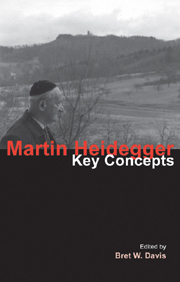Book contents
- Frontmatter
- Contents
- Contributors
- Acknowledgements
- Abbreviations
- Introduction: key concepts in Heidegger's thinking of being
- 1 Hermeneutics of facticity
- 2 Phenomenology: Heidegger after Husserl and the Greeks
- 3 Dasein as being-in-the-world
- 4 Care and authenticity
- 5 Being and time
- 6 The turn
- 7 Heidegger, National Socialism and the German People
- 8 Truth as alētheia and the clearing of beyng
- 9 The work of art
- 10 Ereignis: the event of appropriation
- 11 The history of being
- 12 Will and Gelassenheit
- 13 Ge-stell: enframing as the essence of technology
- 14 Language and poetry
- 15 The fourfold
- 16 Ontotheology and the question of god(s)
- 17 Heidegger on Christianity and divinity: a chronological compendium
- Chronology of Heidegger's life
- Bibliography
- Index
15 - The fourfold
- Frontmatter
- Contents
- Contributors
- Acknowledgements
- Abbreviations
- Introduction: key concepts in Heidegger's thinking of being
- 1 Hermeneutics of facticity
- 2 Phenomenology: Heidegger after Husserl and the Greeks
- 3 Dasein as being-in-the-world
- 4 Care and authenticity
- 5 Being and time
- 6 The turn
- 7 Heidegger, National Socialism and the German People
- 8 Truth as alētheia and the clearing of beyng
- 9 The work of art
- 10 Ereignis: the event of appropriation
- 11 The history of being
- 12 Will and Gelassenheit
- 13 Ge-stell: enframing as the essence of technology
- 14 Language and poetry
- 15 The fourfold
- 16 Ontotheology and the question of god(s)
- 17 Heidegger on Christianity and divinity: a chronological compendium
- Chronology of Heidegger's life
- Bibliography
- Index
Summary
The fourfold (das Geviert) is a thinking of things. The fourfold names the “gathering” of earth, sky, mortals and divinities that comes to constitute the thing for Heidegger. In the late 1940s, operating under a teaching ban imposed by the French authorities in the wake of the Second World War, Heidegger ventures “the boldest statement of his thinking” in announcing the fourfold. First named in the 1949 lecture cycle “Insight Into That Which Is”, held at the private Club zu Bremen, the fourfold brings together the poetic sensibility of Heidegger's Hölderlin interpretations with the esoteric quasi-structural concerns of his notebooks from the 1930s, into a new figure of thought: the thing. The simple things around us – indeed, the things themselves – become the focus of his attention and lead him to a phenomenologically more robust sense of world than heretofore found in his work. This world is a world of things, each a cluster of streaming relations reciprocally determinative of world. The fourfold is the key to understanding the utter relationality of worldly existence, for things are now understood to be the gathering points of the fourfold. Only with the fourfold does Heidegger attain the simplicity of vision adequate to a thinking of thing and world.
Things appeared in Heidegger's thinking before the fourfold. Indeed, it would be shocking if they did not. But the notion of the thing that one finds in Being and Time is rather slim.
- Type
- Chapter
- Information
- Martin HeideggerKey Concepts, pp. 208 - 218Publisher: Acumen PublishingPrint publication year: 2009
- 4
- Cited by

